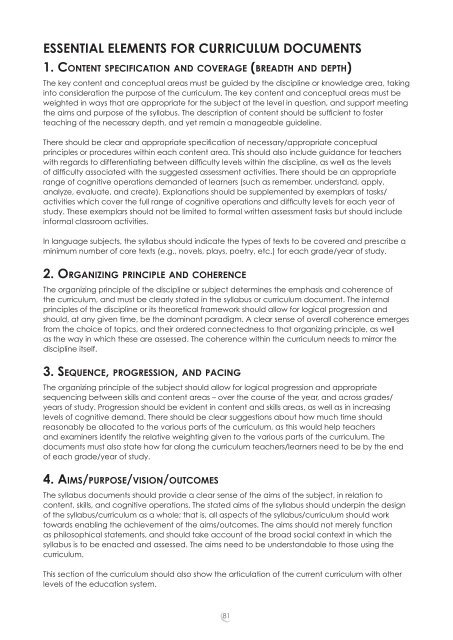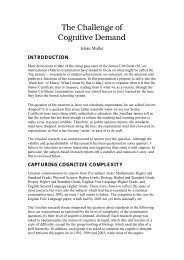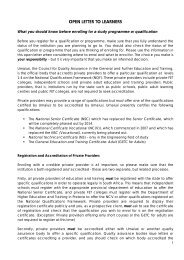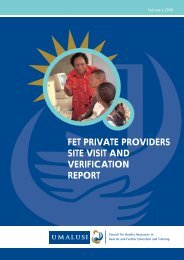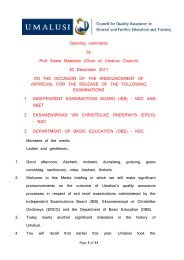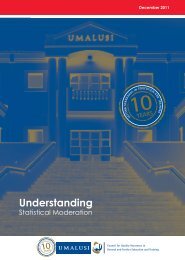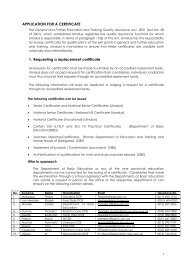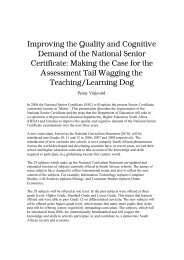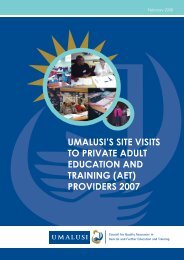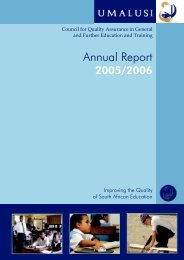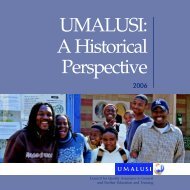Inspecting the Foundations - Umalusi
Inspecting the Foundations - Umalusi
Inspecting the Foundations - Umalusi
Create successful ePaper yourself
Turn your PDF publications into a flip-book with our unique Google optimized e-Paper software.
ESSENTIAL ELEMENTS FOR CURRICULUM DOCUMENTS1. CONTENT SPECIFICATION AND COVERAGE (BREADTH AND DEPTH)The key content and conceptual areas must be guided by <strong>the</strong> discipline or knowledge area, takinginto consideration <strong>the</strong> purpose of <strong>the</strong> curriculum. The key content and conceptual areas must beweighted in ways that are appropriate for <strong>the</strong> subject at <strong>the</strong> level in question, and support meeting<strong>the</strong> aims and purpose of <strong>the</strong> syllabus. The description of content should be suffi cient to fosterteaching of <strong>the</strong> necessary depth, and yet remain a manageable guideline.There should be clear and appropriate specifi cation of necessary/appropriate conceptualprinciples or procedures within each content area. This should also include guidance for teacherswith regards to differentiating between diffi culty levels within <strong>the</strong> discipline, as well as <strong>the</strong> levelsof diffi culty associated with <strong>the</strong> suggested assessment activities. There should be an appropriaterange of cognitive operations demanded of learners (such as remember, understand, apply,analyze, evaluate, and create). Explanations should be supplemented by exemplars of tasks/activities which cover <strong>the</strong> full range of cognitive operations and diffi culty levels for each year ofstudy. These exemplars should not be limited to formal written assessment tasks but should includeinformal classroom activities.In language subjects, <strong>the</strong> syllabus should indicate <strong>the</strong> types of texts to be covered and prescribe aminimum number of core texts (e.g., novels, plays, poetry, etc.) for each grade/year of study.2. ORGANIZING PRINCIPLE AND COHERENCEThe organizing principle of <strong>the</strong> discipline or subject determines <strong>the</strong> emphasis and coherence of<strong>the</strong> curriculum, and must be clearly stated in <strong>the</strong> syllabus or curriculum document. The internalprinciples of <strong>the</strong> discipline or its <strong>the</strong>oretical framework should allow for logical progression andshould, at any given time, be <strong>the</strong> dominant paradigm. A clear sense of overall coherence emergesfrom <strong>the</strong> choice of topics, and <strong>the</strong>ir ordered connectedness to that organizing principle, as wellas <strong>the</strong> way in which <strong>the</strong>se are assessed. The coherence within <strong>the</strong> curriculum needs to mirror <strong>the</strong>discipline itself.3. SEQUENCE, PROGRESSION, AND PACINGThe organizing principle of <strong>the</strong> subject should allow for logical progression and appropriatesequencing between skills and content areas – over <strong>the</strong> course of <strong>the</strong> year, and across grades/years of study. Progression should be evident in content and skills areas, as well as in increasinglevels of cognitive demand. There should be clear suggestions about how much time shouldreasonably be allocated to <strong>the</strong> various parts of <strong>the</strong> curriculum, as this would help teachersand examiners identify <strong>the</strong> relative weighting given to <strong>the</strong> various parts of <strong>the</strong> curriculum. Thedocuments must also state how far along <strong>the</strong> curriculum teachers/learners need to be by <strong>the</strong> endof each grade/year of study.4. AIMS/PURPOSE/VISION/OUTCOMESThe syllabus documents should provide a clear sense of <strong>the</strong> aims of <strong>the</strong> subject, in relation tocontent, skills, and cognitive operations. The stated aims of <strong>the</strong> syllabus should underpin <strong>the</strong> designof <strong>the</strong> syllabus/curriculum as a whole; that is, all aspects of <strong>the</strong> syllabus/curriculum should worktowards enabling <strong>the</strong> achievement of <strong>the</strong> aims/outcomes. The aims should not merely functionas philosophical statements, and should take account of <strong>the</strong> broad social context in which <strong>the</strong>syllabus is to be enacted and assessed. The aims need to be understandable to those using <strong>the</strong>curriculum.This section of <strong>the</strong> curriculum should also show <strong>the</strong> articulation of <strong>the</strong> current curriculum with o<strong>the</strong>rlevels of <strong>the</strong> education system.81


